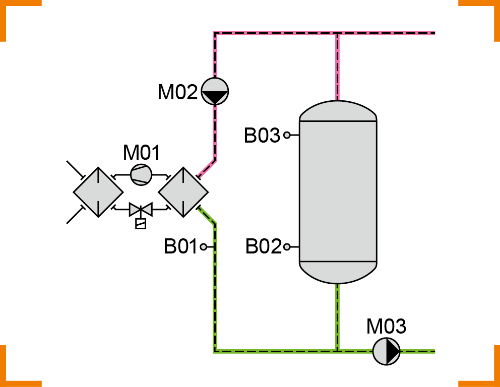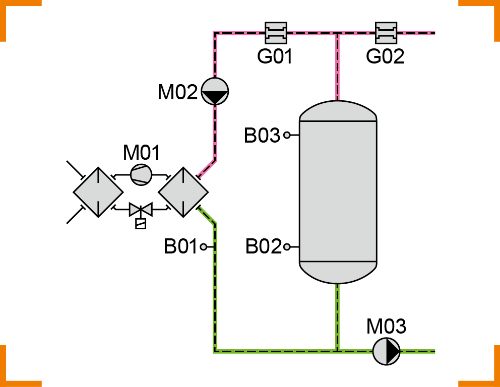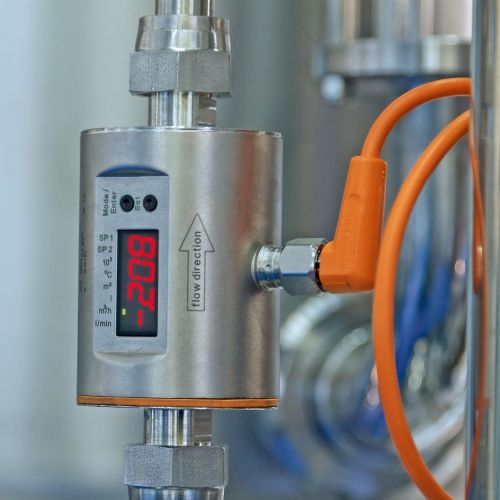HeiVi AG – Avoiding unnecessary waste of energy

Cold storage management using "zero flow" control
In order to reduce costs and energy consumption, the efficient operation of building services systems is becoming increasingly important. This involves more than just the optimal setting of operating times and temperatures. The installations of a building must be viewed holistically. It is essential that the different systems are coordinated with each other.
In the course of the refurbishment of a Nationalbank branch in Basel, all building services installations were renewed. The Swiss HeiVi AG was responsible for planning and project implementation of the heating installations and air-conditioning. The aim was to reduce energy consumption, investment costs and the number of interfaces and optimise building maintenance in a sustainable manner.
Peter Heimann, co-founder of HeiVi AG, explains: "As a planner of advanced heating, ventilation, air conditioning, refrigeration and sanitary installations, we assist architects, building owners and project developers in implementing new systems and optimisation processes. With the aim of achieving maximum energy efficiency and cost-effectiveness while ensuring good comfort for our customers, we stand for innovative building automation planning. To achieve this, we constantly need to think outside the box."
An unnecessary waste of energy
Figure 1 shows the standard functionality of the cooling unit with an output-controlled compressor. The compressor of the cooling unit (M01) regulates the outlet temperature of the cold water (B01). The storage tank charging pump (M02) delivers a constant amount of water via the cold storage tank. Two sensors in the storage tank control the switching on and off of the cooling unit. A storage tank discharging pump (M03) then delivers the cold water to the consumers.
Since the storage tank discharging pump (M03) is controlled by the differential pressure of the consumers, the pump only delivers the amount of water required by the system. The consequence: In partial load operation, the charging mass flow is always much higher than the discharging mass flow. Due to the constant mass flow that feeds the cooling unit, the compressor only reduces its capacity during discharge. The advantages of the output-controlled compressor cannot be leveraged this way.


Figure 1: conventional model, storage tank charging without ifm sensors. Figure 2: Storage tank charging with ifm sensors.

The magnetic-inductive flow meter SM6500 is distinguished by its high accuracy, repeatability and measurement dynamics.
'Thinking outside the box'
"We asked ourselves whether the storage tank charging pump and thus the compressor can be controlled according to need in order to optimise the process", says Heimann. To solve this, we had to "think outside the box". "In the process, we came across the modules from ifm," Heimann continues.
Using SM6500 type flow sensors from ifm, the cold storage tank is set to "zero flow". The storage tank charging pump (M02) is newly integrated into the system. The storage tank charging pump (M02) controls the difference between the storage tank charging mass flow (G01) and the storage tank discharging mass flow (G02). However, the storage tank charging mass flow should be five to ten percent higher than the storage tank discharging mass flow. It also needs to be ensured that the mass flow rate of the cooling unit does not drop below the limit.
Thus, the "zero flow" control by means of ifm flow sensors offers numerous advantages. The compressor runs in partial load operation and the capacity regulation of the compressor is fully utilised. This means less energy consumption. The energy consumption is also minimised by high inlet temperatures into the cooling unit. As a result, the cold storage tank can have smaller dimensions, reducing investment costs. There is additional savings potential due to the fact that the storage tank charging pump (M02) in the model (see figure 2) consumes less energy.
No thermometer required
In addition to the SM6500 flow sensors, TD2237 temperature sensors from ifm were used. Unlike conventional temperature sensors, they feature a digital temperature display. This eliminates the need for an additional thermometer. Apart from enabling fast and accurate measurement, the digital display of the ifm sensors simplifies set-up and process optimisation. Errors in the circuit can be detected and eliminated immediately.
Conclusion
The success of the new solution shows that Heimann is right: HeiVi AG has already equipped several branches of Baseler Kantonsbank, Bank Cler in St. Gallen and the laboratory of Baugewerbliche Berufsschule in Zurich using the new procedure. Always on board: the sensors from ifm.

The temperature transmitter TD2237 features a very short response time and a display.